Lecture 1 LANGUAGE. GENERAL NOTIONS. PLAN 1.
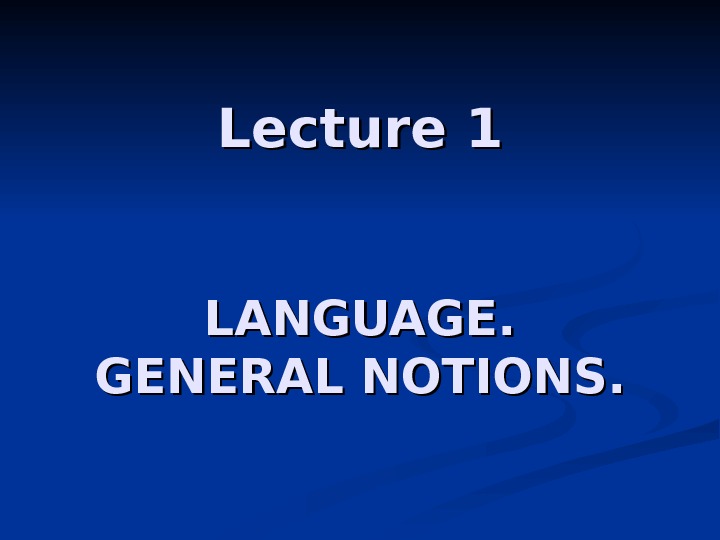
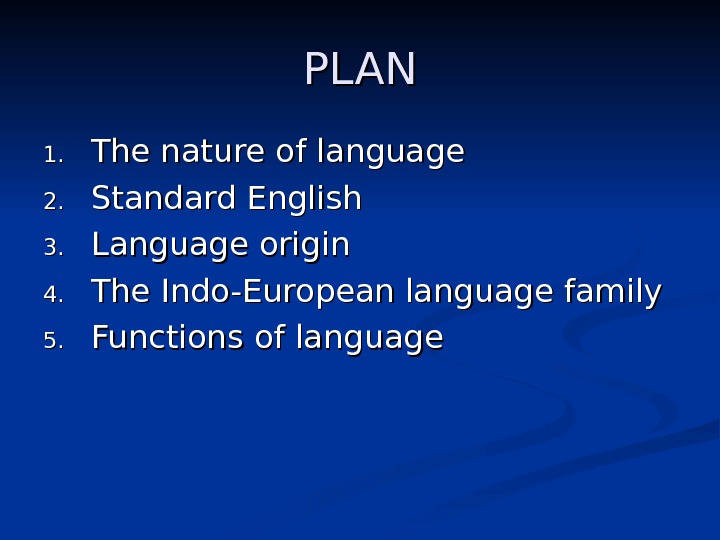
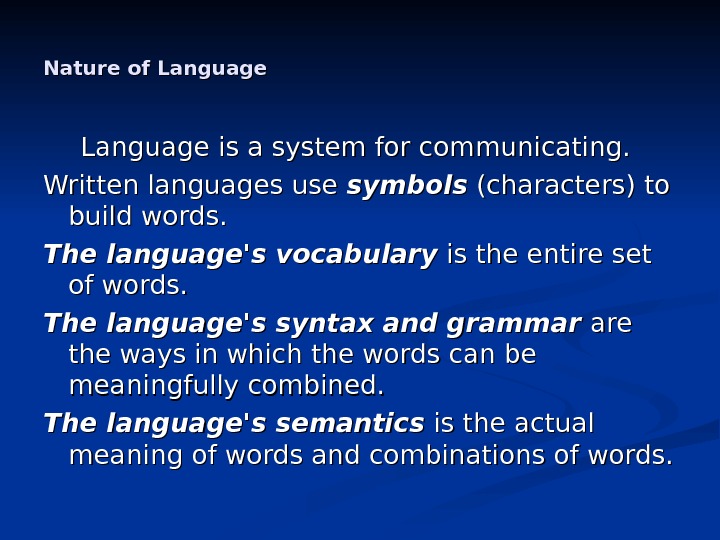
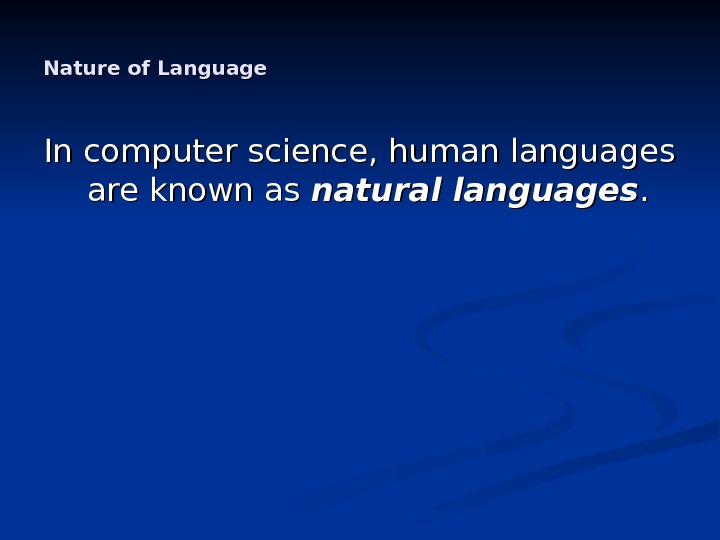
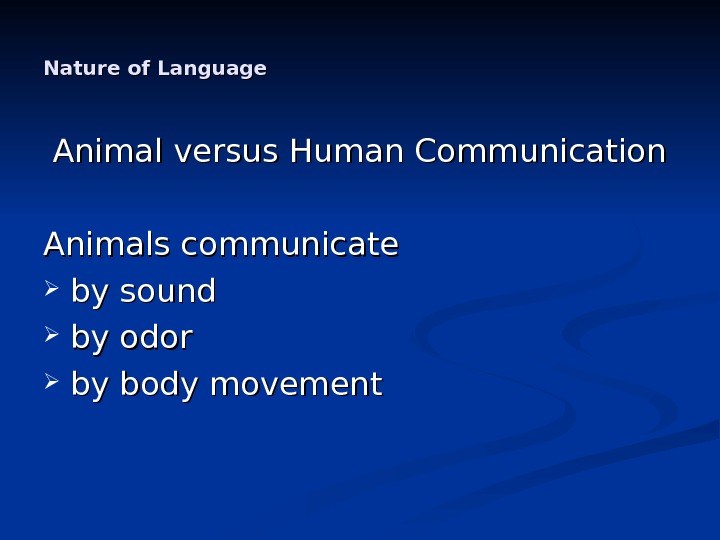
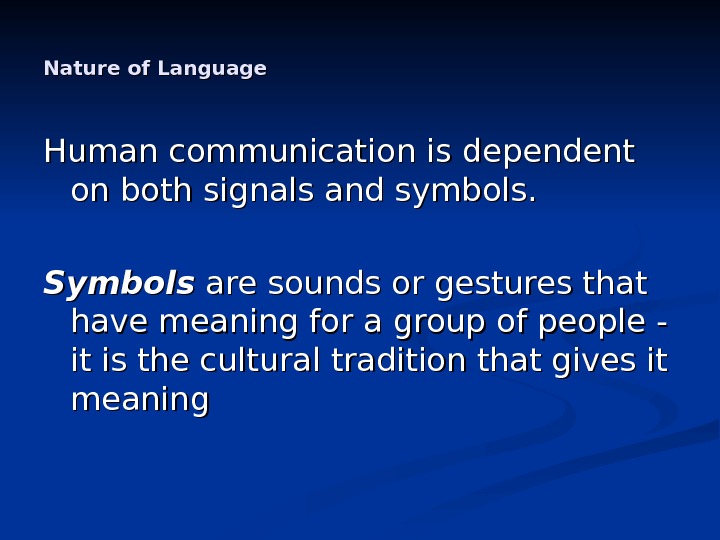
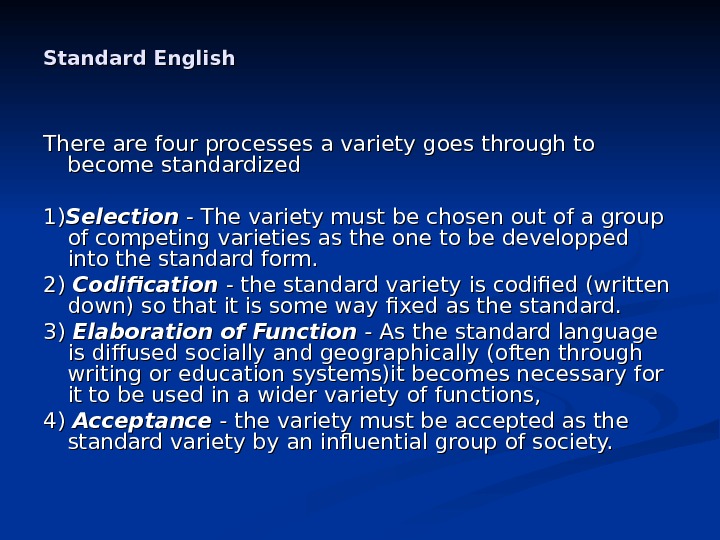
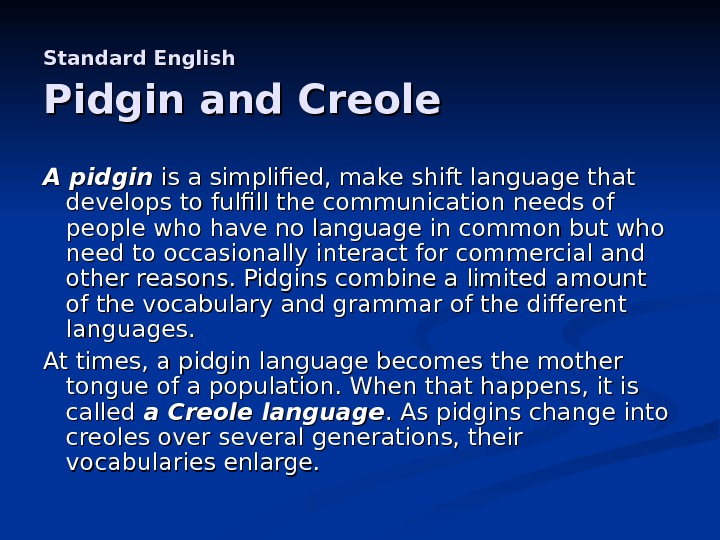
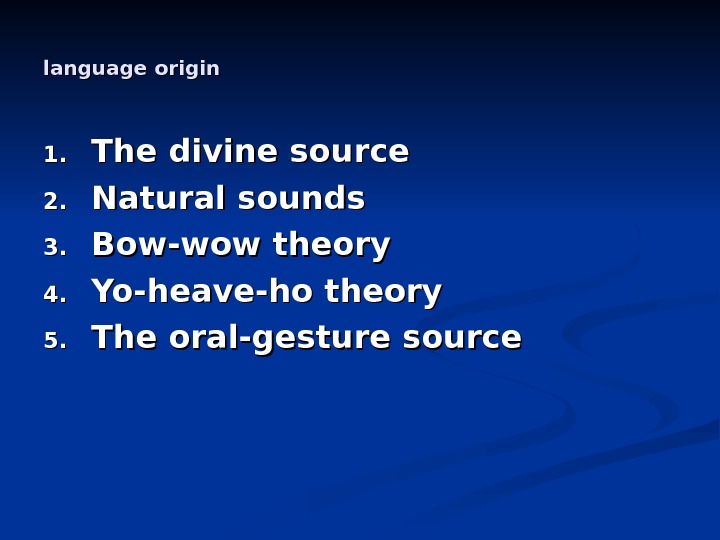
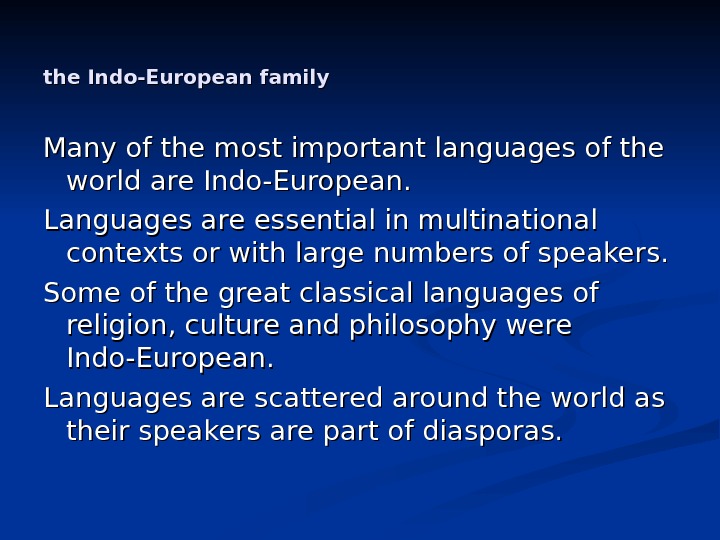
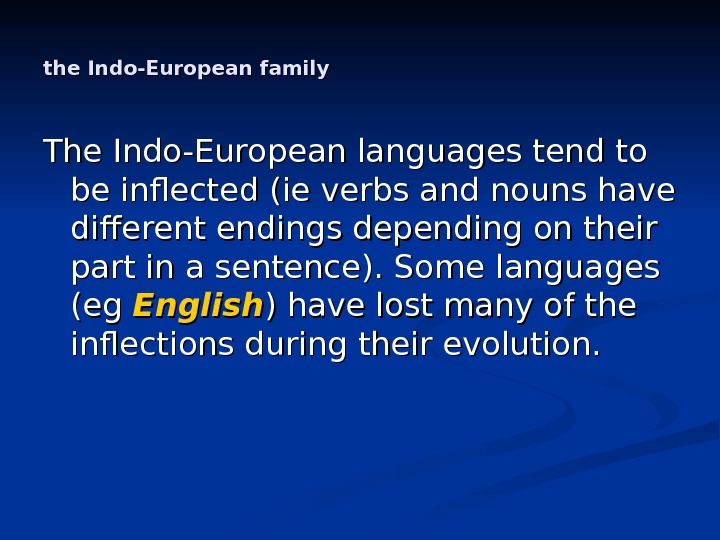
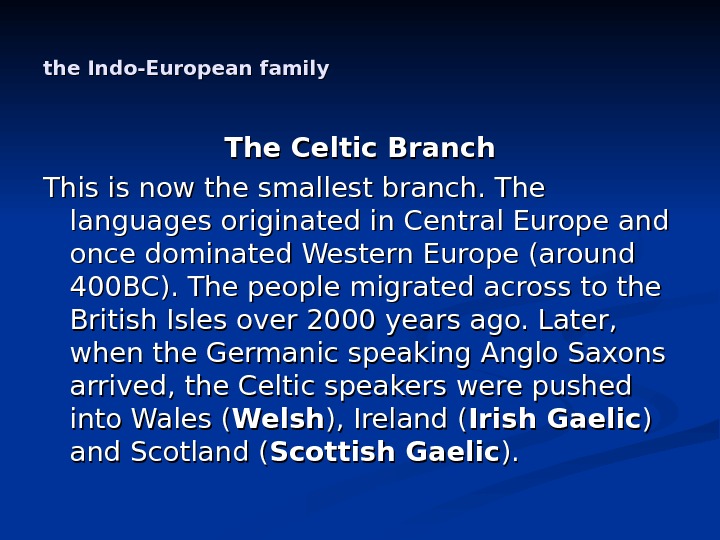

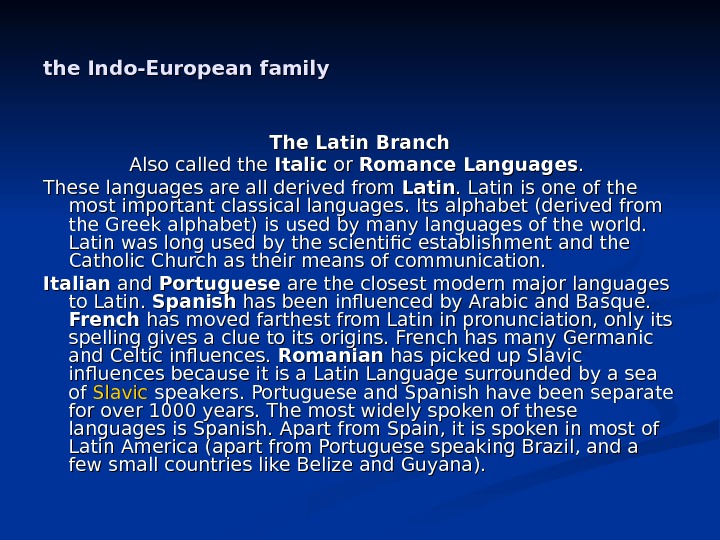
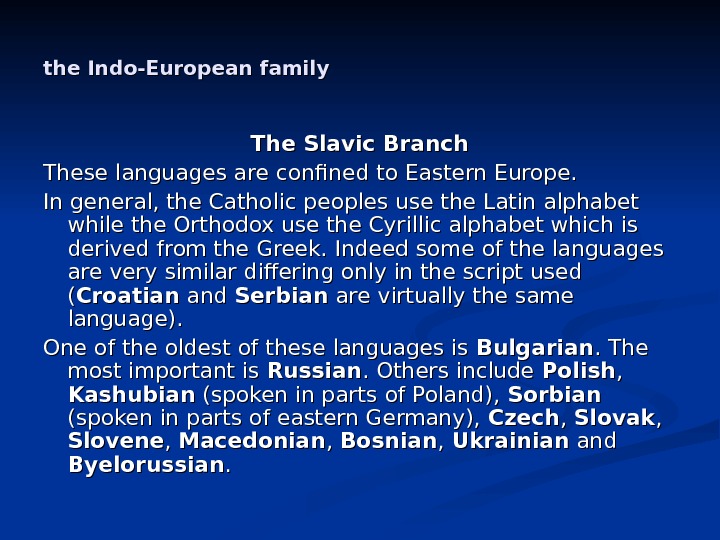
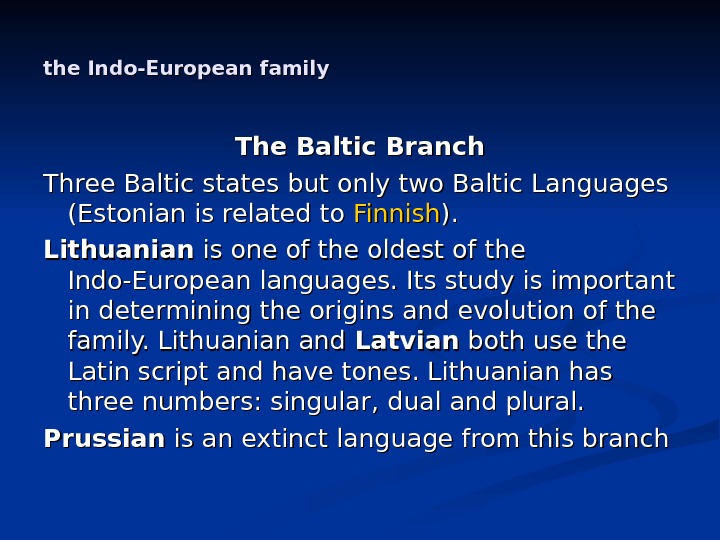
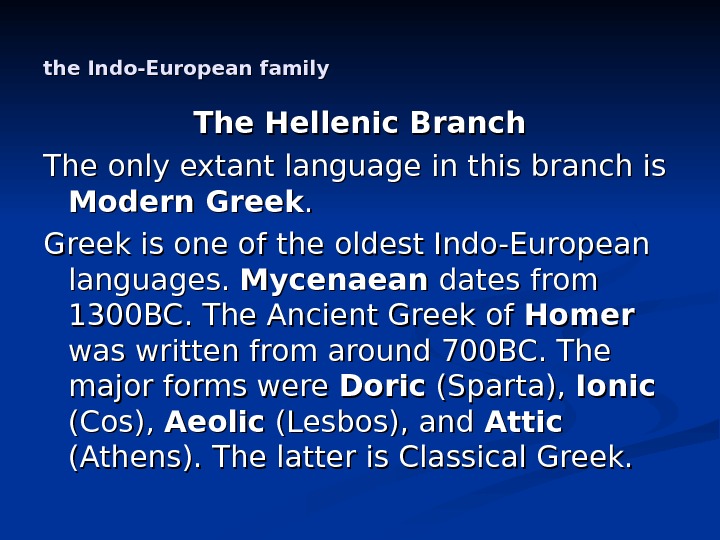

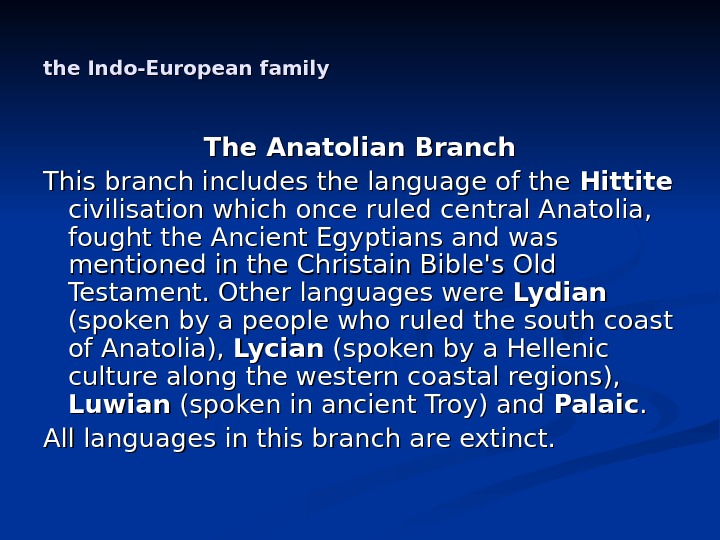
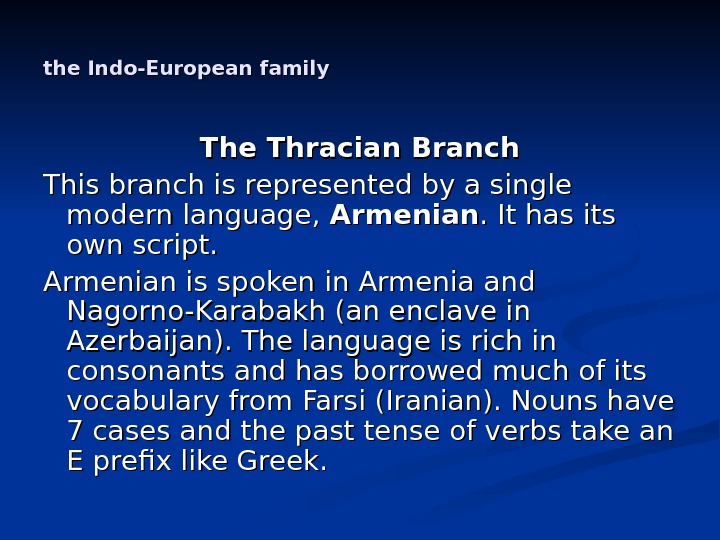
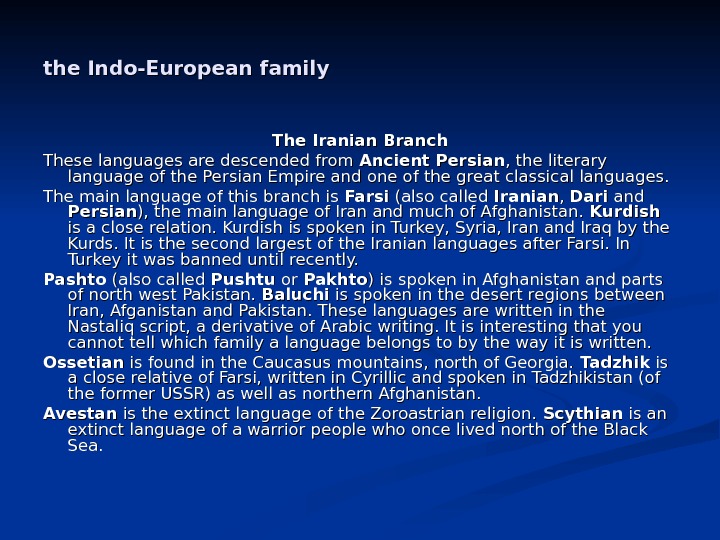
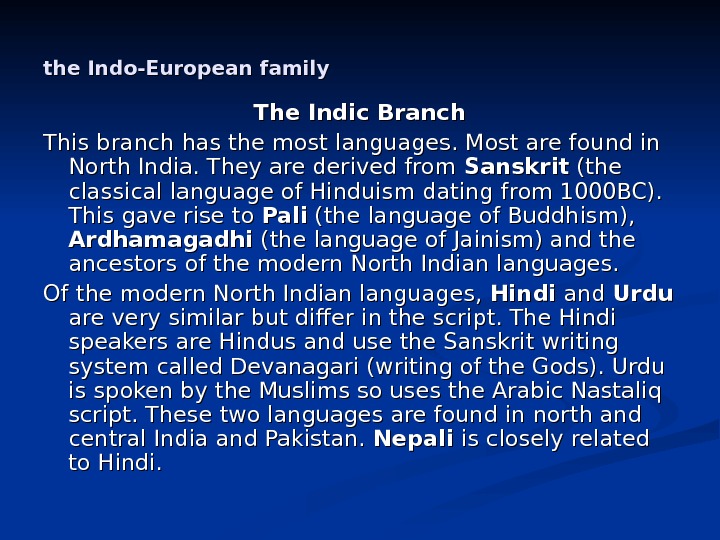
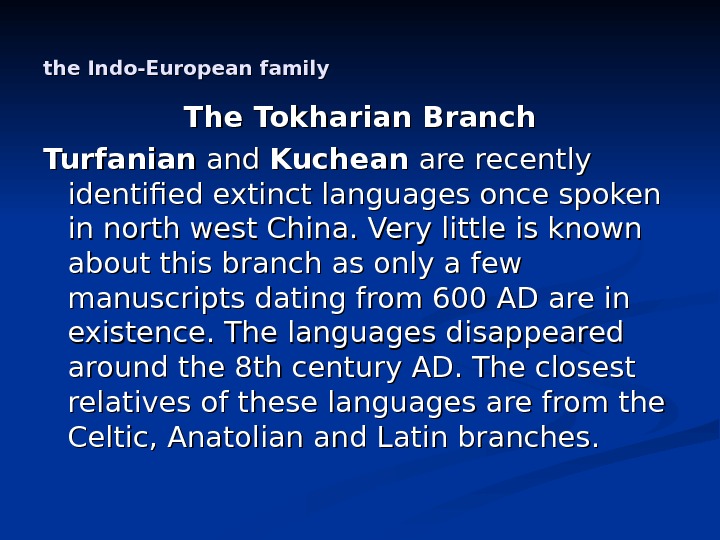
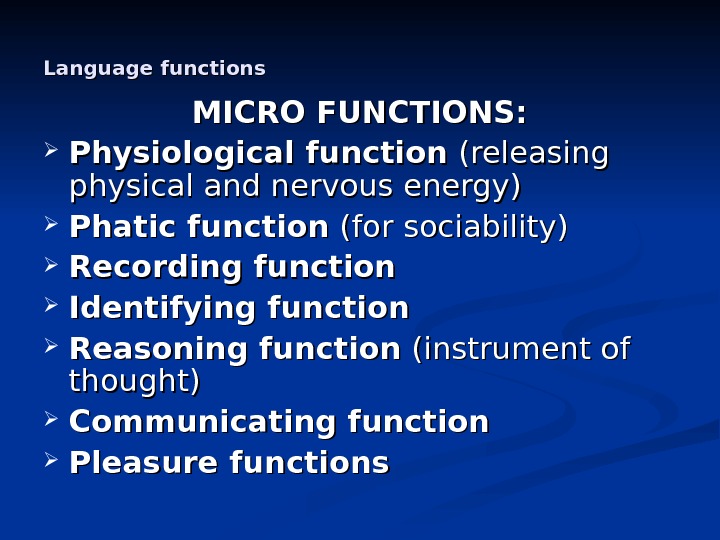
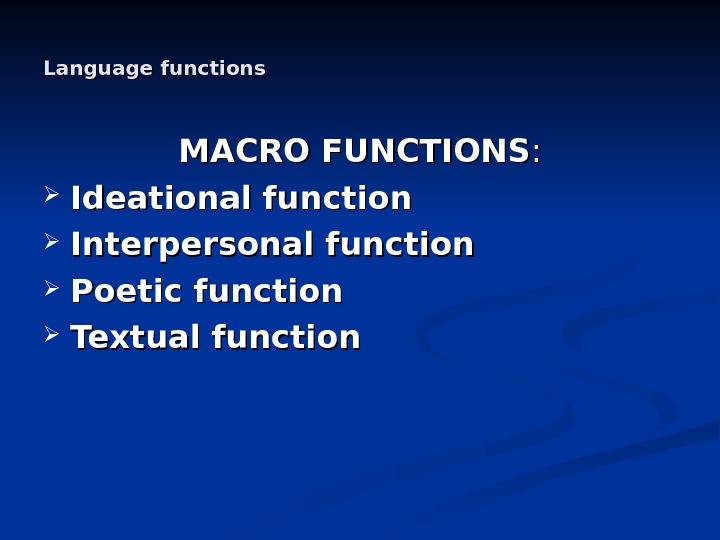
lecture_1_the_system_of_the_language.ppt
- Размер: 83 Кб
- Количество слайдов: 25
Описание презентации Lecture 1 LANGUAGE. GENERAL NOTIONS. PLAN 1. по слайдам
 Lecture 1 LANGUAGE. GENERAL NOTIONS.
Lecture 1 LANGUAGE. GENERAL NOTIONS.
 PLAN 1. 1. The nature of language 2. 2. Standard English 3. 3. Language origin 4. 4. The Indo-European language family 5. 5. Functions of language
PLAN 1. 1. The nature of language 2. 2. Standard English 3. 3. Language origin 4. 4. The Indo-European language family 5. 5. Functions of language
 Nature of Language is a system for communicating. Written languages use symbols (characters) to build words. The language’s vocabulary is the entire set of words. The language’s syntax and grammar are the ways in which the words can be meaningfully combined. The language’s semantics is the actual meaning of words and combinations of words.
Nature of Language is a system for communicating. Written languages use symbols (characters) to build words. The language’s vocabulary is the entire set of words. The language’s syntax and grammar are the ways in which the words can be meaningfully combined. The language’s semantics is the actual meaning of words and combinations of words.
 Nature of Language In computer science, human languages are known as natural languages. .
Nature of Language In computer science, human languages are known as natural languages. .
 Nature of Language Animal versus Human Communication Animals communicate by sound by odor by body movement
Nature of Language Animal versus Human Communication Animals communicate by sound by odor by body movement
 Nature of Language Human communication is dependent on both signals and symbols. Symbols are sounds or gestures that have meaning for a group of people — it is the cultural tradition that gives it meaning
Nature of Language Human communication is dependent on both signals and symbols. Symbols are sounds or gestures that have meaning for a group of people — it is the cultural tradition that gives it meaning
 Standard English There are four processes a variety goes through to become standardized 1)1) Selection — The variety must be chosen out of a group of competing varieties as the one to be developped into the standard form. 2) 2) Codification — the standard variety is codified (written down) so that it is some way fixed as the standard. 3) 3) Elaboration of Function — As the standard language is diffused socially and geographically (often through writing or education systems)it becomes necessary for it to be used in a wider variety of functions, 4) 4) Acceptance — the variety must be accepted as the standard variety by an influential group of society.
Standard English There are four processes a variety goes through to become standardized 1)1) Selection — The variety must be chosen out of a group of competing varieties as the one to be developped into the standard form. 2) 2) Codification — the standard variety is codified (written down) so that it is some way fixed as the standard. 3) 3) Elaboration of Function — As the standard language is diffused socially and geographically (often through writing or education systems)it becomes necessary for it to be used in a wider variety of functions, 4) 4) Acceptance — the variety must be accepted as the standard variety by an influential group of society.
 Standard English Pidgin and Creole A pidgin is a simplified, make shift language that develops to fulfill the communication needs of people who have no language in common but who need to occasionally interact for commercial and other reasons. Pidgins combine a limited amount of the vocabulary and grammar of the different languages. At times, a pidgin language becomes the mother tongue of a population. When that happens, it is called a Creole language. As pidgins change into creoles over several generations, their vocabularies enlarge.
Standard English Pidgin and Creole A pidgin is a simplified, make shift language that develops to fulfill the communication needs of people who have no language in common but who need to occasionally interact for commercial and other reasons. Pidgins combine a limited amount of the vocabulary and grammar of the different languages. At times, a pidgin language becomes the mother tongue of a population. When that happens, it is called a Creole language. As pidgins change into creoles over several generations, their vocabularies enlarge.
 language origin 1. 1. The divine source 2. 2. Natural sounds 3. 3. Bow-wow theory 4. 4. Yo-heave-ho theory 5. 5. The oral-gesture source
language origin 1. 1. The divine source 2. 2. Natural sounds 3. 3. Bow-wow theory 4. 4. Yo-heave-ho theory 5. 5. The oral-gesture source
 the Indo-European family Many of the most important languages of the world are Indo-European. Languages are essential in multinational contexts or with large numbers of speakers. Some of the great classical languages of religion, culture and philosophy were Indo-European. Languages are scattered around the world as their speakers are part of diasporas.
the Indo-European family Many of the most important languages of the world are Indo-European. Languages are essential in multinational contexts or with large numbers of speakers. Some of the great classical languages of religion, culture and philosophy were Indo-European. Languages are scattered around the world as their speakers are part of diasporas.
 the Indo-European family The Indo-European languages tend to be inflected (ie verbs and nouns have different endings depending on their part in a sentence). Some languages (eg English ) have lost many of the inflections during their evolution.
the Indo-European family The Indo-European languages tend to be inflected (ie verbs and nouns have different endings depending on their part in a sentence). Some languages (eg English ) have lost many of the inflections during their evolution.
 the Indo-European family The Celtic Branch This is now the smallest branch. The languages originated in Central Europe and once dominated Western Europe (around 400 BC). The people migrated across to the British Isles over 2000 years ago. Later, when the Germanic speaking Anglo Saxons arrived, the Celtic speakers were pushed into Wales ( Welsh ), Ireland ( Irish Gaelic ) ) and Scotland ( Scottish Gaelic ). ).
the Indo-European family The Celtic Branch This is now the smallest branch. The languages originated in Central Europe and once dominated Western Europe (around 400 BC). The people migrated across to the British Isles over 2000 years ago. Later, when the Germanic speaking Anglo Saxons arrived, the Celtic speakers were pushed into Wales ( Welsh ), Ireland ( Irish Gaelic ) ) and Scotland ( Scottish Gaelic ). ).
 the Indo-European family The Germanic Branch These languages originate from Old Norse and Saxon. Due to the influence of early Christian missionaries, the vast majority of the Celtic and Germanic languages use the Latin Alphabet. They include English , the second most spoken language in the world, the most widespread, the language of technology, and the language with the largest vocabulary. A useful language to have as your mother tongue. Dutch and German are the closest major languages related to English. An even closer relative is Frisian. . Flemish and Afrikaans are varieties of Dutch while Yiddish is a variety of German. Yiddish is written using the Hebrew script. Three of the four (mainland) Scandinavian languages belong to this branch: ( Danish , , Norwegian , and Swedish ). Swedish has tones, unusual in European languages. The fourth Scandinavian language, Finnish, belongs to a different family. Icelandic is the least changed of the Germanic Languages — being close to Old Norse. Another old language is Faroese. . Gothic (Central Europe), Frankish (France), Lombardo (Danube region), Visigoth (Iberian Peninsula) and Vandal (North Africa) are extinct languages from this branch.
the Indo-European family The Germanic Branch These languages originate from Old Norse and Saxon. Due to the influence of early Christian missionaries, the vast majority of the Celtic and Germanic languages use the Latin Alphabet. They include English , the second most spoken language in the world, the most widespread, the language of technology, and the language with the largest vocabulary. A useful language to have as your mother tongue. Dutch and German are the closest major languages related to English. An even closer relative is Frisian. . Flemish and Afrikaans are varieties of Dutch while Yiddish is a variety of German. Yiddish is written using the Hebrew script. Three of the four (mainland) Scandinavian languages belong to this branch: ( Danish , , Norwegian , and Swedish ). Swedish has tones, unusual in European languages. The fourth Scandinavian language, Finnish, belongs to a different family. Icelandic is the least changed of the Germanic Languages — being close to Old Norse. Another old language is Faroese. . Gothic (Central Europe), Frankish (France), Lombardo (Danube region), Visigoth (Iberian Peninsula) and Vandal (North Africa) are extinct languages from this branch.
 the Indo-European family The Latin Branch Also called the Italic or or Romance Languages. . These languages are all derived from Latin is one of the most important classical languages. Its alphabet (derived from the Greek alphabet) is used by many languages of the world. Latin was long used by the scientific establishment and the Catholic Church as their means of communication. Italian and Portuguese are the closest modern major languages to Latin. Spanish has been influenced by Arabic and Basque. French has moved farthest from Latin in pronunciation, only its spelling gives a clue to its origins. French has many Germanic and Celtic influences. Romanian has picked up Slavic influences because it is a Latin Language surrounded by a sea of of Slavic speakers. Portuguese and Spanish have been separate for over 1000 years. The most widely spoken of these languages is Spanish. Apart from Spain, it is spoken in most of Latin America (apart from Portuguese speaking Brazil, and a few small countries like Belize and Guyana).
the Indo-European family The Latin Branch Also called the Italic or or Romance Languages. . These languages are all derived from Latin is one of the most important classical languages. Its alphabet (derived from the Greek alphabet) is used by many languages of the world. Latin was long used by the scientific establishment and the Catholic Church as their means of communication. Italian and Portuguese are the closest modern major languages to Latin. Spanish has been influenced by Arabic and Basque. French has moved farthest from Latin in pronunciation, only its spelling gives a clue to its origins. French has many Germanic and Celtic influences. Romanian has picked up Slavic influences because it is a Latin Language surrounded by a sea of of Slavic speakers. Portuguese and Spanish have been separate for over 1000 years. The most widely spoken of these languages is Spanish. Apart from Spain, it is spoken in most of Latin America (apart from Portuguese speaking Brazil, and a few small countries like Belize and Guyana).
 the Indo-European family The Slavic Branch These languages are confined to Eastern Europe. In general, the Catholic peoples use the Latin alphabet while the Orthodox use the Cyrillic alphabet which is derived from the Greek. Indeed some of the languages are very similar differing only in the script used (( Croatian and Serbian are virtually the same language). One of the oldest of these languages is Bulgarian. The most important is Russian. Others include Polish , , Kashubian (spoken in parts of Poland), Sorbian (spoken in parts of eastern Germany), Czech , , Slovak , , Slovene , , Macedonian , , Bosnian , , Ukrainian and Byelorussian. .
the Indo-European family The Slavic Branch These languages are confined to Eastern Europe. In general, the Catholic peoples use the Latin alphabet while the Orthodox use the Cyrillic alphabet which is derived from the Greek. Indeed some of the languages are very similar differing only in the script used (( Croatian and Serbian are virtually the same language). One of the oldest of these languages is Bulgarian. The most important is Russian. Others include Polish , , Kashubian (spoken in parts of Poland), Sorbian (spoken in parts of eastern Germany), Czech , , Slovak , , Slovene , , Macedonian , , Bosnian , , Ukrainian and Byelorussian. .
 the Indo-European family The Baltic Branch Three Baltic states but only two Baltic Languages (Estonian is related to Finnish ). ). Lithuanian is one of the oldest of the Indo-European languages. Its study is important in determining the origins and evolution of the family. Lithuanian and Latvian both use the Latin script and have tones. Lithuanian has three numbers: singular, dual and plural. Prussian is an extinct language from this branch
the Indo-European family The Baltic Branch Three Baltic states but only two Baltic Languages (Estonian is related to Finnish ). ). Lithuanian is one of the oldest of the Indo-European languages. Its study is important in determining the origins and evolution of the family. Lithuanian and Latvian both use the Latin script and have tones. Lithuanian has three numbers: singular, dual and plural. Prussian is an extinct language from this branch
 the Indo-European family The Hellenic Branch The only extant language in this branch is Modern Greek. . Greek is one of the oldest Indo-European languages. Mycenaean dates from 1300 BC. The Ancient Greek of Homer was written from around 700 BC. The major forms were Doric (Sparta), Ionic (Cos), Aeolic (Lesbos), and Attic (Athens). The latter is Classical Greek.
the Indo-European family The Hellenic Branch The only extant language in this branch is Modern Greek. . Greek is one of the oldest Indo-European languages. Mycenaean dates from 1300 BC. The Ancient Greek of Homer was written from around 700 BC. The major forms were Doric (Sparta), Ionic (Cos), Aeolic (Lesbos), and Attic (Athens). The latter is Classical Greek.
 the Indo-European family The Illyric Branch Another single language branch. Only Albanian (called Shqip by its speakers) belongs to this branch. It has been written in the Latin script since 1909; this replaced a number of writing systems including Greek and Arabic scripts. Albanian has many avoidance words. Instead of saying wolf , the phrase may God close its mouth is used. The definate article is shown by a suffix: BUKBUK ( ( bread ) ) BUKA ( ( the bread ). ). Many noun plurals are irregular.
the Indo-European family The Illyric Branch Another single language branch. Only Albanian (called Shqip by its speakers) belongs to this branch. It has been written in the Latin script since 1909; this replaced a number of writing systems including Greek and Arabic scripts. Albanian has many avoidance words. Instead of saying wolf , the phrase may God close its mouth is used. The definate article is shown by a suffix: BUKBUK ( ( bread ) ) BUKA ( ( the bread ). ). Many noun plurals are irregular.
 the Indo-European family The Anatolian Branch This branch includes the language of the Hittite civilisation which once ruled central Anatolia, fought the Ancient Egyptians and was mentioned in the Christain Bible’s Old Testament. Other languages were Lydian (spoken by a people who ruled the south coast of Anatolia), Lycian (spoken by a Hellenic culture along the western coastal regions), Luwian (spoken in ancient Troy) and Palaic. . All languages in this branch are extinct.
the Indo-European family The Anatolian Branch This branch includes the language of the Hittite civilisation which once ruled central Anatolia, fought the Ancient Egyptians and was mentioned in the Christain Bible’s Old Testament. Other languages were Lydian (spoken by a people who ruled the south coast of Anatolia), Lycian (spoken by a Hellenic culture along the western coastal regions), Luwian (spoken in ancient Troy) and Palaic. . All languages in this branch are extinct.
 the Indo-European family The Thracian Branch This branch is represented by a single modern language, Armenian. It has its own script. Armenian is spoken in Armenia and Nagorno-Karabakh (an enclave in Azerbaijan). The language is rich in consonants and has borrowed much of its vocabulary from Farsi (Iranian). Nouns have 7 cases and the past tense of verbs take an E prefix like Greek.
the Indo-European family The Thracian Branch This branch is represented by a single modern language, Armenian. It has its own script. Armenian is spoken in Armenia and Nagorno-Karabakh (an enclave in Azerbaijan). The language is rich in consonants and has borrowed much of its vocabulary from Farsi (Iranian). Nouns have 7 cases and the past tense of verbs take an E prefix like Greek.
 the Indo-European family The Iranian Branch These languages are descended from Ancient Persian , the literary language of the Persian Empire and one of the great classical languages. The main language of this branch is Farsi (also called Iranian , , Dari and Persian ), the main language of Iran and much of Afghanistan. Kurdish is a close relation. Kurdish is spoken in Turkey, Syria, Iran and Iraq by the Kurds. It is the second largest of the Iranian languages after Farsi. In Turkey it was banned until recently. Pashto (also called Pushtu or or Pakhto ) is spoken in Afghanistan and parts of north west Pakistan. Baluchi is spoken in the desert regions between Iran, Afganistan and Pakistan. These languages are written in the Nastaliq script, a derivative of Arabic writing. It is interesting that you cannot tell which family a language belongs to by the way it is written. Ossetian is found in the Caucasus mountains, north of Georgia. Tadzhik is is a close relative of Farsi, written in Cyrillic and spoken in Tadzhikistan (of the former USSR) as well as northern Afghanistan. Avestan is the extinct language of the Zoroastrian religion. Scythian is an extinct language of a warrior people who once lived north of the Black Sea.
the Indo-European family The Iranian Branch These languages are descended from Ancient Persian , the literary language of the Persian Empire and one of the great classical languages. The main language of this branch is Farsi (also called Iranian , , Dari and Persian ), the main language of Iran and much of Afghanistan. Kurdish is a close relation. Kurdish is spoken in Turkey, Syria, Iran and Iraq by the Kurds. It is the second largest of the Iranian languages after Farsi. In Turkey it was banned until recently. Pashto (also called Pushtu or or Pakhto ) is spoken in Afghanistan and parts of north west Pakistan. Baluchi is spoken in the desert regions between Iran, Afganistan and Pakistan. These languages are written in the Nastaliq script, a derivative of Arabic writing. It is interesting that you cannot tell which family a language belongs to by the way it is written. Ossetian is found in the Caucasus mountains, north of Georgia. Tadzhik is is a close relative of Farsi, written in Cyrillic and spoken in Tadzhikistan (of the former USSR) as well as northern Afghanistan. Avestan is the extinct language of the Zoroastrian religion. Scythian is an extinct language of a warrior people who once lived north of the Black Sea.
 the Indo-European family The Indic Branch This branch has the most languages. Most are found in North India. They are derived from Sanskrit (the classical language of Hinduism dating from 1000 BC). This gave rise to Pali (the language of Buddhism), Ardhamagadhi (the language of Jainism) and the ancestors of the modern North Indian languages. Of the modern North Indian languages, Hindi and Urdu are very similar but differ in the script. The Hindi speakers are Hindus and use the Sanskrit writing system called Devanagari (writing of the Gods). Urdu is spoken by the Muslims so uses the Arabic Nastaliq script. These two languages are found in north and central India and Pakistan. Nepali is closely related to Hindi.
the Indo-European family The Indic Branch This branch has the most languages. Most are found in North India. They are derived from Sanskrit (the classical language of Hinduism dating from 1000 BC). This gave rise to Pali (the language of Buddhism), Ardhamagadhi (the language of Jainism) and the ancestors of the modern North Indian languages. Of the modern North Indian languages, Hindi and Urdu are very similar but differ in the script. The Hindi speakers are Hindus and use the Sanskrit writing system called Devanagari (writing of the Gods). Urdu is spoken by the Muslims so uses the Arabic Nastaliq script. These two languages are found in north and central India and Pakistan. Nepali is closely related to Hindi.
 the Indo-European family The Tokharian Branch Turfanian and Kuchean are recently identified extinct languages once spoken in north west China. Very little is known about this branch as only a few manuscripts dating from 600 AD are in existence. The languages disappeared around the 8 th century AD. The closest relatives of these languages are from the Celtic, Anatolian and Latin branches.
the Indo-European family The Tokharian Branch Turfanian and Kuchean are recently identified extinct languages once spoken in north west China. Very little is known about this branch as only a few manuscripts dating from 600 AD are in existence. The languages disappeared around the 8 th century AD. The closest relatives of these languages are from the Celtic, Anatolian and Latin branches.
 Language functions MICRO FUNCTIONS: Physiological function (releasing physical and nervous energy) Phatic function (for sociability) Recording function Identifying function Reasoning function (instrument of thought) Communicating function Pleasure functions
Language functions MICRO FUNCTIONS: Physiological function (releasing physical and nervous energy) Phatic function (for sociability) Recording function Identifying function Reasoning function (instrument of thought) Communicating function Pleasure functions
 Language functions MACRO FUNCTIONS : : Ideational function Interpersonal function Poetic function Textual function
Language functions MACRO FUNCTIONS : : Ideational function Interpersonal function Poetic function Textual function
